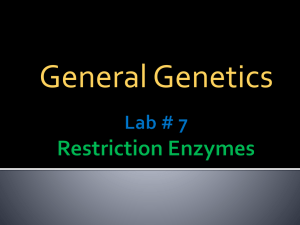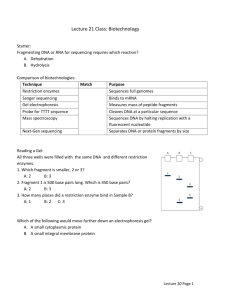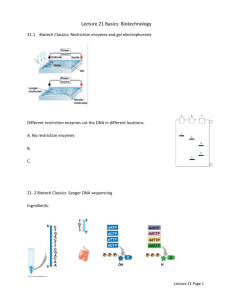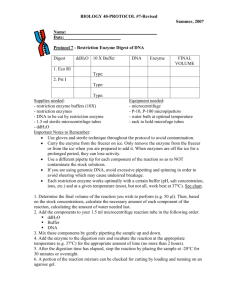Experiment 3 The enzymolysis of DNA and the agarose gel
advertisement
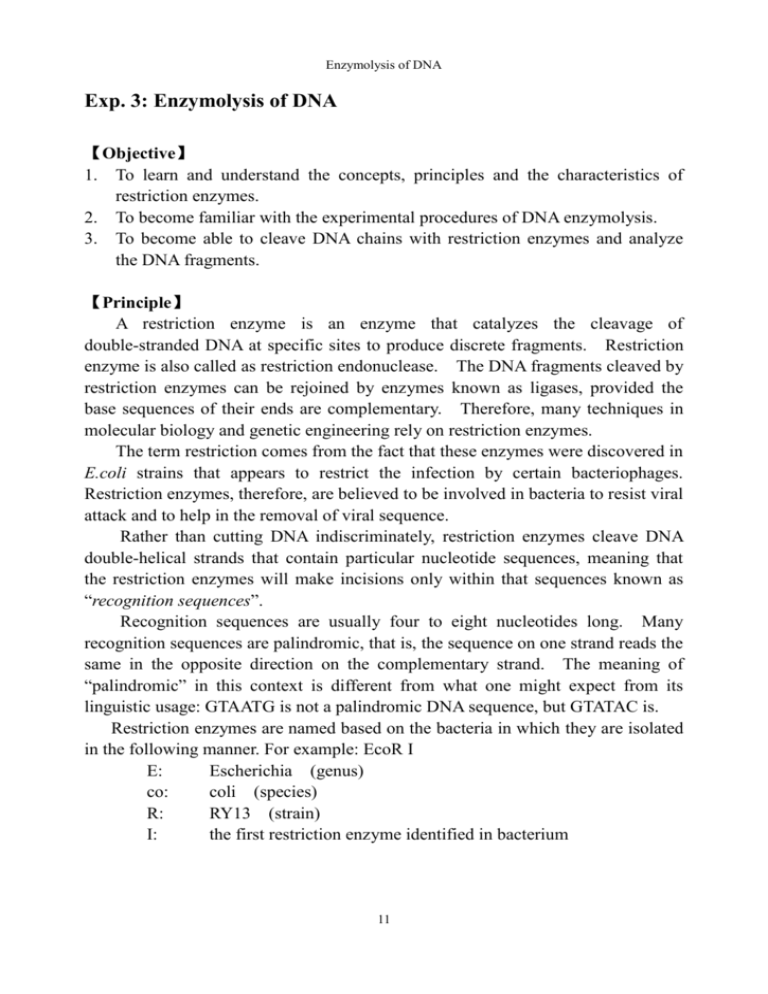
Enzymolysis of DNA Exp. 3: Enzymolysis of DNA 【Objective】 1. To learn and understand the concepts, principles and the characteristics of restriction enzymes. 2. To become familiar with the experimental procedures of DNA enzymolysis. 3. To become able to cleave DNA chains with restriction enzymes and analyze the DNA fragments. 【Principle】 A restriction enzyme is an enzyme that catalyzes the cleavage of double-stranded DNA at specific sites to produce discrete fragments. Restriction enzyme is also called as restriction endonuclease. The DNA fragments cleaved by restriction enzymes can be rejoined by enzymes known as ligases, provided the base sequences of their ends are complementary. Therefore, many techniques in molecular biology and genetic engineering rely on restriction enzymes. The term restriction comes from the fact that these enzymes were discovered in E.coli strains that appears to restrict the infection by certain bacteriophages. Restriction enzymes, therefore, are believed to be involved in bacteria to resist viral attack and to help in the removal of viral sequence. Rather than cutting DNA indiscriminately, restriction enzymes cleave DNA double-helical strands that contain particular nucleotide sequences, meaning that the restriction enzymes will make incisions only within that sequences known as “recognition sequences”. Recognition sequences are usually four to eight nucleotides long. Many recognition sequences are palindromic, that is, the sequence on one strand reads the same in the opposite direction on the complementary strand. The meaning of “palindromic” in this context is different from what one might expect from its linguistic usage: GTAATG is not a palindromic DNA sequence, but GTATAC is. Restriction enzymes are named based on the bacteria in which they are isolated in the following manner. For example: EcoR I E: Escherichia (genus) co: coli (species) R: RY13 (strain) I: the first restriction enzyme identified in bacterium 11 Enzymolysis of DNA Examples Enzyme Source Restriction Sequence Cut Hind III Haemophilus influenzae 5’ AAGCTT 3’ 3’ TTCGAA 5’ 5’ A 3’ TTCGA AGCTT 3’ A 5’ Pst I Providencia stuartii 5’ CTGCAG 3’ 3’GACGTC 5’ 5’ CTGCA 3’ G G 3’ ACGTC 5’ Alu I Arthrobacter luteus 5’ AGCT 3’ 3’ TCGA 5’ 5’ AG 3’ TC CT 3’ GA 5’ Restriction enzymes are classified biochemically into three types, designated Type I, Type II and Type III. Type I and III systems, in general, are a single large enzyme complex of methylase and restriction cutting functions. Although these enzymes recognize specific DNA sequences, the sites of actual cleavage are from these recognition sites with variable distances, and can be hundreds of bases away. In type II systems, the restriction enzyme is independent of its methylase, and cleavages occur at very specific sites that are within or close to the recognition sequence. The majority of known restriction enzymes are type II, which demonstrates the most versatile uses as laboratory tools. The restriction enzymes most used in molecular biology labs cut within their recognition sites and generate one of three different types of ends. In the diagrams below, the recognition site is boxed. 5’overhangs: 5’-A-T-G-G-A-T-C-C-A-A-3’ 3’-T-A-C-C-T-A-G-G-T-T-5’ 5’-ATG 3’-TACCTAG’ GATCCAA-3’ GTT-5’ 3’overhangs: 5’-G-A-G-G-T-A-C-C-C-T-3’ 3’-C-T-C-C-A-T-G-G-G-A-5’ Bam H1 Kpn Ⅰ 5’-GAGGTAC 3’-CTC CCT-3’ CATGGGA- 5’ Bluts 5’-T-A-C-C-C-G-G-G-T-C-3’ 3’-A-T-G-G-G-C-C-C-A-G-5’ Sma Ⅰ 5’-TACCC 3’-ATGGG GGGTC-3’ CCCAG-5’ The 5’or 3’ overhangs generated asymmetrically by enzymes are called sticky ends or cohesive ends, because they readily stick or anneal with their partner by 12 Enzymolysis of DNA base pairing. 【Experimental Materials】 1. λDNA (Lamda DNA) (0.38μg/μl) 2. Hind III: 16u/μl, XHo Ⅰ 3. Enzymolysis buffer (Tris-HCl, NaCl, MgCl2, DTT) 4. Stopping solution (Bromophenol blue 1%, SDS 1%, EDTA 2%, glycerol 50%) 【Procedure】 1. Prepare 4 eppendorf tubes. Add reagents listed in the table below into each tube. Volume: μl λDNA Hind III XHo I ddH2O 2. 3. 4. 5. Tube 1 Tube 2 Tube 3 Tube 4 10 / / 10 10 5 / 5 10 / 5 5 10 5 5 / Close the cap of each tube tightly. Mix well using vertex and centrifuge the tube. 【Note: The centrifugation is very important. The total amount of sample is very small, vertex can cause sample to stick on the inter wall of the tube.】 Rest these eppendorf tubes onto a tube rack. Incubate the rack into a water bath at 37℃ for 2 hours. Take out the tubes from the water bath. Add 5μl of stopping solution in each tube. Run electrophoresis to analyze the DNA fragments (See next). 13

